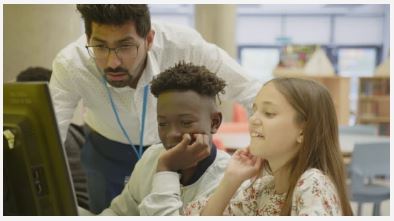Steps for Teachers to make Instructional Videos
Now you can replace your lectures with your own videos. This boosts students’ engagement and frees your time to work with your students instead.
- Ideas inspired by Kareem Farah, Robert Barnett August 20, 2019

Imagine lecturing to a class in which some of your students are left levels behind due to absence or else, some are levels ahead, some have special needs, or some were absent. It’s pretty hard to do that effectively, isn’t it?
As teachers in our Learning Management System, we have an instructional course built around self-made videos that lets students at all levels or grades to learn at their own pace and build mastery skill-by-skill. And you as teachers can use these videos in your own classrooms as well:
- It helps traditional lecture-style teaching by freeing you up to work directly with individual students;
- It allows time for creative thinking, give directions for projects and other complex tasks; and
- It provides students to learn from any lecture again and again.

At AukSunLMS, we train teachers to create blended learning classrooms of their own. The key is empowering educators to build their own high-quality instructional videos. We also promote high quality externally created videos, as these videos allow teachers to gain faster. Teachers can provide direct instruction via videos while also circulating around the room, answering questions and guiding students to deeper learning.
STEP 1: CHUNK INSTRUCTION
Multiple short videos are better than one long video. Research on instructional videos shows that learner engagement with videos begins to drop after the 6-minutes—and it falls dramatically after 9 minutes. So it’s essential to chunk instruction such that each video covers a single learning objective or task, and nothing more.
STEP 2: BUILD VIDEO-READY SLIDES
Use visual cues to highlight key information, and minimize the use of on-screen text. The slides that a teacher would use in a lecture may not work in a video—it’s critical to build a slide deck that is clear, simple, and visually compelling. (We have templates for many subjects).
STEP 3: RECORD
There are many tools you can use to create a strong instructional video. At AukSunLMS we train the teachers with tools that can really simplify the process and enhance the quality of the video.
 Recording device: Ideally, you have a touch-screen tablet or laptop with a high-quality stylus. This ensures that you can easily annotate visuals and show work. Handwriting also adds a nice personal touch. But if you have a non-touch-screen laptop, or a tablet but no stylus, you can still make your own videos.
Recording device: Ideally, you have a touch-screen tablet or laptop with a high-quality stylus. This ensures that you can easily annotate visuals and show work. Handwriting also adds a nice personal touch. But if you have a non-touch-screen laptop, or a tablet but no stylus, you can still make your own videos.
Screencasting program: AukSunLMS uses the best programs allowing educators to pause and re-record specific segments of their video easily, which removes the pressure of getting a perfect take. We have many such programs that have robust video editors and embedded annotation tools.
Microphone: This is often forgotten, but it’s really helpful to have a pair of headphones with an external mic—these headphones help you improve the sound quality and ensure that your videos don’t contain background noise.
AukSunLMS uses highlighting, annotating, and a computer screencast to show teachers how to create their own tutorials. The clarity of voice and the video helps students follow along, even with a complex task.
STEP 4: ENHANCE ENGAGEMENT
Simply sitting and watching videos can lead students to lose focus—the best instructional videos keep them actively engaged. When students take notes or answer guided questions while watching, they retain material better than students who watch passively. Embedding questions in your instructional video improve student interaction.
STEP 5: BE YOURSELF
The most effective blended instruction is being personal. Don’t be afraid to make mistakes, and make sure your authentic personality shines through. Videos in which the instructor speaks in a natural, conversational manner, with an enthusiastic tone, are the most engaging. In our experience, students really appreciate knowing that it’s their actual teacher behind the video.
Learning to create a high-quality instructional video doesn’t happen overnight—it requires continual trial, error, and innovation. We’ve been recording videos for years, and we still often struggle to be compelling and concise. Yet we keep trying, because we believe that teacher-driven blended instruction is what’s best for our students. So start planning, grab some recording software, be yourself, and take your school to the next level!